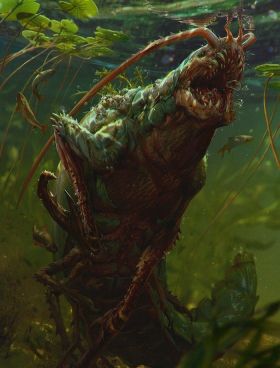Difference between revisions of "Giant Crayfish"
Tao alexis (talk | contribs) |
Tao alexis (talk | contribs) |
||
| Line 18: | Line 18: | ||
}} | }} | ||
| − | '''Giant crayfish''' are intimidating [[Lake|lake]] creatures found along the wetland and sodden areas adjacent to freshwater lakes and tropical nyanza. They dwell | + | '''Giant crayfish''' are intimidating [[Lake|lake]] creatures found along the wetland and sodden areas adjacent to freshwater lakes and tropical nyanza. They may also be found in drowned swamps. They dwell submerged holes dug into the hard clay, preferring to feed and rest beneath the surface. When hunting, giant crayfish wander swampy areas just below the surface, causing a wake that doesn't quite break the water. |
| − | [[File:Giant Crayfish.jpg|left|280px]] | + | [[File:Giant Crayfish.jpg|left|280px|thumb]] |
| − | + | == Behaviour == | |
| + | They're largely scavenging creatures, but if provoked they've been known to [[Attacking in Combat|attack]]. Giant crayfish have been known to attack small surface boats, '''capsizing''' or swamping water over the gunnels, attacking with one claw before sinking below the surface. Villagers are careful to attack these crayfish from firm ground; success produces a great deal of [[Food|food]] — though giant crayfish rarely approach close to a bank. The meat from a giant crayfish is edible and can, if preserved and transported to a market, be sold for a good price. | ||
== Advantages == | == Advantages == | ||
Revision as of 02:11, 14 August 2023
| Species | mollusk |
| No. Appearing | 1–4 |
| Behaviour | solitary |
| Range | profundal, wetland |
| Size | 8 ft. long |
| Weight | 1,300 lbs. |
| Intelligence | 0 |
| Armour Class | 4 |
| Hit Dice | 4+4 |
| Action Points | 4 |
| Max. Stride | {{{stride}}} |
| THAC0 | 18 |
| Hp/Die | d12 |
| Attack Forms | pincer/pincer |
| Damage | 2–12/2–12 |
| Special Attacks | capsizing, claw, surprise on a 1-3 |
Giant crayfish are intimidating lake creatures found along the wetland and sodden areas adjacent to freshwater lakes and tropical nyanza. They may also be found in drowned swamps. They dwell submerged holes dug into the hard clay, preferring to feed and rest beneath the surface. When hunting, giant crayfish wander swampy areas just below the surface, causing a wake that doesn't quite break the water.
Behaviour
They're largely scavenging creatures, but if provoked they've been known to attack. Giant crayfish have been known to attack small surface boats, capsizing or swamping water over the gunnels, attacking with one claw before sinking below the surface. Villagers are careful to attack these crayfish from firm ground; success produces a great deal of food — though giant crayfish rarely approach close to a bank. The meat from a giant crayfish is edible and can, if preserved and transported to a market, be sold for a good price.
Advantages
When attacking out of the water, crayfish surprise 1-3 out of 6. From the water, they can attack with only one claw; but if their legs find firm purchase on the bottom, they will attack with both. They always attack the same target when fighting with both claws.
The claws will seize a creature if the crayfish succeeds in stunning it; the claws will close in a vise-like grip. This causes 1-4 damage per round; to get free, the victim must have a strength of at least 18/30 or the crayfish must be killed. Once the crayfish has a victim, it will back into the water as soon as possible, in order to drown its victim — storing it underwater until it is ready to be eaten.
See Bestiary
